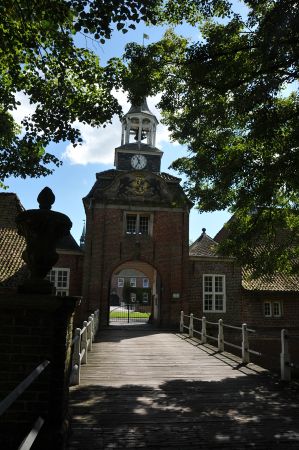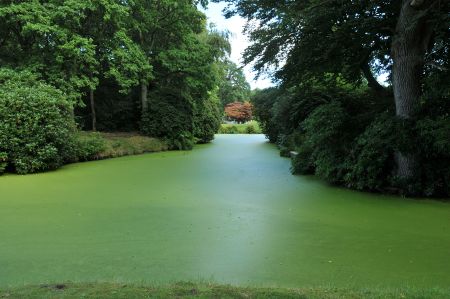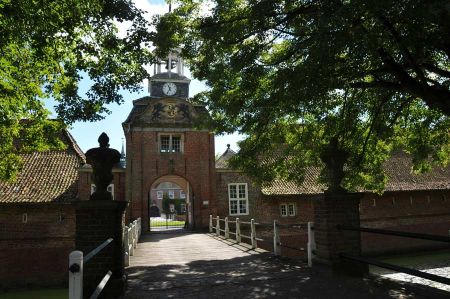Early romantic park at the moated castle of Lütetsburg
- Written by Portal Editor
Our preparatory planning for the coming year had once again taken us to northern Germany, this time the region around Norden and Norddeich was our destination.
The focus of our interest this time was the moated castle of Lütetsburg, its outer bailey and, above all, its unique landscape garden, which is open to the public as a park and is one of the few examples of early romantic gardens that have been preserved on the continent.
But let's start a little with the history of this moated castle complex, where a so-called Uthof (outer courtyard) of the Manninga chief family, the lords of Westeel, Pewsum and Bergum, had been built since 1212. Lütet I. Manninga probably had this outer courtyard converted into a stone house around the middle of the 14th century. He, Lütet, gave his name to the castle and the town of Lütetsburg that developed around it.
On October 9, 1373 there was a great flood

After the flood, the Leybucht reached its greatest extent at around 13,000 hectares, and the village of Westeel also had to be abandoned. As a result, the tide is said to have reached the city north, where the waves could penetrate to the walls of the Dominican monastery. From then on, the city had access to the North Sea and was given a port.
The water also penetrated deep inland via the bays of Sielmönken and Campen, which are now silted up. In the late 14th century, the parishes of Drewert and Walsum as well as the village of Ham were destroyed on the Rysumer Rücken. The historian Ubbo Emmius reports the effects in the 1590s:

Due to the loss of the ancestral seat in Westeel, the grandson of Lütet II continued to expand the first stone house in Lütetsburg into a four-winged castle until 1430. The foundation walls of today's castle date back to this time. In 1514, during the Saxon Feud, troops of the Black Guard destroyed the castle in revenge for the East Frisian Count Edzard II having stolen three ammunition ships from them.
After Unico Manninga's death, his only daughter Hyma inherited the castle. By marrying the Reichsfreiherr Wilhelm zu Innhausen und Knyphausen in 1588, Lütetsburg came into the possession of the Knyphausen family (today the Counts zu Innhausen and Knyphausen), who are still the owners of Lütetsburg Castle with its park and forest.
Count Edzard zu Innhausen und Knyphausen had the palace rebuilt in Neo-Renaissance style between 1894 and 1896 by the renowned Hanoverian architect Hermann Schaedtler. Schaedtler based his design on historical models from the Dutch-Danish Renaissance on the one hand, but also on more recent castle buildings in the family of the client on the other. A further expansion of the castle took place until 1908.
From the previous buildings, only the elongated brick building of the outer bailey and the gate tower have been preserved. The Inn- und Knyphausen family had the brick building of the outer bailey parallel to the street built in the 16th century in the style of the Dutch Renaissance. The two-storey gate tower with a round arch passageway, side pilasters, curved sandstone gables and lions holding coats of arms was built in 1731 in the centre of the outer bailey.
Castle Park Lütetsburg - First explanations by the court gardener
Even today, Folkert Fischer often thinks of the time when Wilhelm Edzard zu Inn- und Knyphausen (1908 - 1978) was his boss. "Do you have time?" the lord of the castle asked him on that last day in March 1954. And Fischer had hardly said yes when von Knyphausen said: "Then start tomorrow!"
Those were good times." In 1973, Fischer then took over everything gardening from his predecessor Kaiser; Retirement followed in 1995, after 41 years. Guided tours of the park remained his profession, and hardly a day goes by when Fischer doesn't make sure things are all right. He always called his boss at the time "Prince" and addressed him as such; as did everyone in Lütetsburg and the surrounding area. The two men always spoke in Low German, which is how they understood each other best.
The turn to Romanticism in the spirit of Jean-Jacques Rousseau, which began in the second half of the 18th century, can be clearly seen in the complex. It is one of the few surviving examples of this early romantic garden type on the continent with 30 hectares of old trees, rare exotic plants, rhododendrons and azaleas.
From ponds and watercourses, which are sometimes completely covered in green with duck curd, we reach a lookout hill, a wooden church based on the Norwegian model, find a great variety of tree species and plants. In short, it is a wonderful park landscape that invites you to go for a long day of walking, not just because of the idyllic paths. We spend hours in the park just to watch the play of light and shadow in the water of the ponds.
Please read as well:
Land yachting on sandy expanses of IJmuden Beach
Sremska Mitrovica from the perspective of an architect
https://www.alaturka.info/en/germany/lower-saxony/6265-early-romantic-park-at-the-moated-castle-of-luetetsburg/amp#sigProIdeaf5224146
